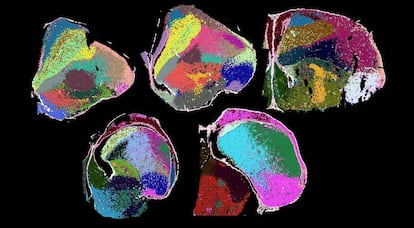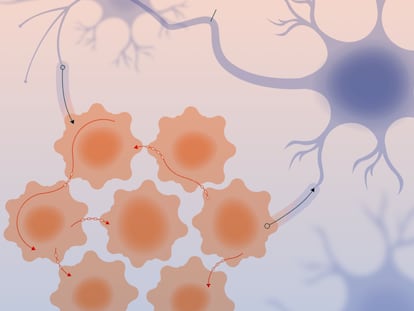Mammals, birds, and reptiles evolved complex brains through different paths
Three studies of the brain regions responsible for processing sensory information show that their neurons are and communicate differently

Butterflies, pigeons, and bats have one thing in common: they fly. Common sense might suggest that, despite belonging to different families, they share a common winged ancestor on the tree of life. However, their closest ancestor is an ancient, worm-like creature that did not even have wings. This is a clear example of evolutionary convergence, where vastly different species have independently evolved the same solution (wings) to solve the same problem (flight). A similar phenomenon has occurred in the brains of birds, reptiles, and mammals. According to three studies published in Science, their grey matter has evolved to perform complex functions, using different neural paths and circuits to reach the same destination.
Until well into the last century, scientists placed humans at the pinnacle of evolution, with great apes and some cetaceans occupying the next tier. This anthropocentrism gave rise to a concept that could be called “mammal-centrism,” positioning mammals as a more advanced evolutionary stage than other vertebrates, such as birds, reptiles, amphibians, and fish.
This idea was reinforced each time scientists examined the brain of an animal. Mammalian brains have a distinctive anatomy, with convolutions and grooves that provide greater capacity. In fact, the rest of the taxa lack the neocortex — the outermost part of the pallium, responsible for the most advanced functions. However, by comparing the brain anatomy and neurons of mice, chickens, and geckos (a species similar to salamanders), a team of researchers has found that, much like wings, brains across different species may have converged over the course of evolution, despite their apparent differences.
Fernando García Moreno, an Ikerbasque researcher at the Achucarro Basque Center for Neuroscience, is the lead author of two of the three studies on vertebrate brain evolution published in Science. “Mammals have an enlarged pallium and a gigantic cortex. When you compare it with that of a gecko, for example, you see that the pallium is just another part,” says García Moreno, who is also a professor at the University of the Basque Country (UPV/EHU).
“The neocortex is responsible for cognitive and associative functions such as language, reasoning, sensory processing, and visual and auditory information,” he explains. “The debate, dating back 100 years, is that in any mammal, you see a cortex with six layers of cells, as Cajal observed. If you look at a reptile, you see three layers, and with neurons, only two. That suggested that we had made progress. But then we saw that birds [which are sauropsids, like most reptiles] don’t have a cortex; their neurons are grouped into nuclei,” he adds. Despite these differences, mice, chickens, and geckos share equivalent neural circuits.

Focusing on birds, García Moreno’s team, in collaboration with researchers from Swedish, Canadian, and Spanish institutions, studied neurogenesis and the development of sensory circuits in chickens. Specifically, they examined the emergence and migration of the two main types of neurons found in every brain — particularly in the pallium: excitatory neurons and inhibitory neurons. These function like the brain’s on/off switches — excitatory neurons send signals across different brain regions to drive communication, while inhibitory neurons regulate, refine, and sometimes even block those signals.
“What we have found is that the development of these structures and these neurons is very different in the species [birds and mammals],” says García Moreno.
According to evolutionary and developmental theories, this means they cannot be the same. “They could not have been present in a common ancestor 350 million years ago because they would have inherited the same method of circuit formation or neuron differentiation,” he explains. It is estimated that around 350 million years ago, tetrapods (four-limbed vertebrates) diverged into different groups of vertebrates.
The discovery that vertebrates evolved functionally similar neural circuits through different pathways is supported by another study also published in Science. Co-led by Professor Henrik Kaessmann of the University of Heidelberg (Germany) and García Moreno in Bilbao, this research created a detailed atlas of pallium cells, both in adult birds and during chick embryonic development. “Our research shows that inhibitory neurons are surprisingly similar in birds and mammals, suggesting they existed in a shared ancestor over 320 million years ago and have changed very little since then. However, excitatory neurons evolved in a much more dynamic way,” says Bastienne Zaremba, the study’s first author and a member of Kaessmann’s team, in an email.
Evolutionary duality
The preservation of neurons that silence synapses and block communication is not exclusive to birds. It has also been observed in mammals, fish, amphibians (though not included in this study), and even in lampreys — an ancient, eel-like creature often mistaken for a fish but belonging to a much older lineage, possibly descending from the earliest vertebrates. At the same time, excitatory neurons have diversified significantly throughout evolution.
Neuroscientist Mónica Muñoz from the University of Castilla-La Mancha in Spain highlights this finding as one of the most significant in these studies. “The fact that the evolution of excitatory neurons differs from that of inhibitory neurons can provide insight into their distinct functions in the brain, including in humans,” explains Muñoz, who was not involved in the research. This duality could be highly relevant.
“On the one hand, it seems that inhibition is something that has been maintained, because phylogenetically it is more common among species. Meanwhile, excitation varies between species. My impression is that inhibitory mechanisms have been conserved, while excitatory neurons have evolved divergently,” Muñoz adds. She believes this makes perfect sense: “Regardless of whether it’s a lizard, a chicken, a mouse, or a human, we all exist in an environment and everyone perceives if it’s raining, if it’s cold or if the person approaching is dangerous or not.”

In an informative article also published in Science, Columbia University researchers Maria Antonietta Tosches and Giacomo Gattoni emphasize a key takeaway from this trio of studies: “Taken together, these results show that the similarity of the neural circuits in birds and mammals is the result of evolutionary convergence rather than [coming from] a common ancestor.”
For Víctor Borrell, head of the Neurogenesis and Cortical Expansion group at the Institute of Neurosciences of Miguel Hernández University and the CSIC, this convergence carries great significance. “It shows us that there are different ways to build the same brain function during embryonic development,” he explains.
This concept — akin to the idea that all roads lead to Rome — suggests that convergence provides an optimal solution for constructing neural circuits capable of complex cognitive functions. However, Borrell quickly notes that this applies primarily to terrestrial animals. Other cases, such as the octopus, challenge any definitive conclusions: “Cephalopods, especially octopuses, are a paradigmatic example. They exhibit remarkable cognitive abilities (intelligence?) but have brains that are fundamentally different from those of any vertebrate.”
Among the broader implications of these studies, Bastienne Zaremba, lead author of the Science paper mapping the chicken pallium, highlights the role of different types of neurons in cognitive function. “Other animals, such as reptiles, amphibians, and even some fish, also have inhibitory neurons similar to those in mammals and birds. Yet, they do not display the same advanced cognitive abilities.” This suggests that the key to intelligence may lie in excitatory neurons. “The fact that excitatory neurons differ significantly between birds and mammals implies that these two lineages achieve similar circuit architecture in different ways. This basically means that they found two different ways to develop intelligence.”
Sign up for our weekly newsletter to get more English-language news coverage from EL PAÍS USA Edition
Tu suscripción se está usando en otro dispositivo
¿Quieres añadir otro usuario a tu suscripción?
Si continúas leyendo en este dispositivo, no se podrá leer en el otro.
FlechaTu suscripción se está usando en otro dispositivo y solo puedes acceder a EL PAÍS desde un dispositivo a la vez.
Si quieres compartir tu cuenta, cambia tu suscripción a la modalidad Premium, así podrás añadir otro usuario. Cada uno accederá con su propia cuenta de email, lo que os permitirá personalizar vuestra experiencia en EL PAÍS.
¿Tienes una suscripción de empresa? Accede aquí para contratar más cuentas.
En el caso de no saber quién está usando tu cuenta, te recomendamos cambiar tu contraseña aquí.
Si decides continuar compartiendo tu cuenta, este mensaje se mostrará en tu dispositivo y en el de la otra persona que está usando tu cuenta de forma indefinida, afectando a tu experiencia de lectura. Puedes consultar aquí los términos y condiciones de la suscripción digital.
More information
Archived In
Últimas noticias
Mustafa Suleyman: ‘Controlling AI is the challenge of our time’
Venezuela breaks energy agreements with Trinidad and Tobago due to alleged complicity with the US
The murder of Michele and Rob Reiner: A tale of horrific days in Hollywood
Trump orders a ‘complete blockade of sanctioned oil tankers’ going to and from Venezuela
Most viewed
- ‘El Limones’ and the growing union disguise of Mexican organized crime
- Christian Louboutin: ‘Young people don’t want to be like their parents. And if their parents wear sneakers, they’re going to look for something else’
- ‘We are dying’: Cuba sinks into a health crisis amid medicine shortages and misdiagnosis
- A mountaineer, accused of manslaughter for the death of his partner during a climb: He silenced his phone and refused a helicopter rescue
- The low-cost creative revolution: How technology is making art accessible to everyone











































